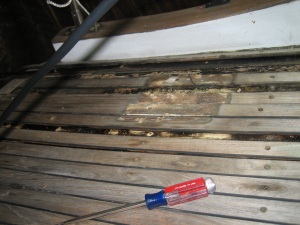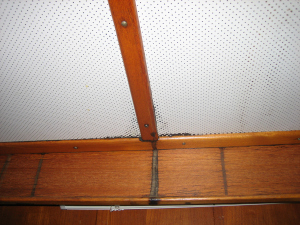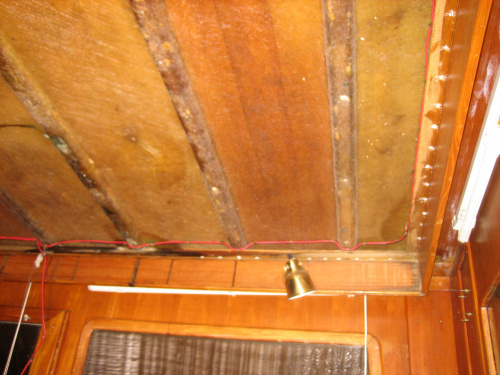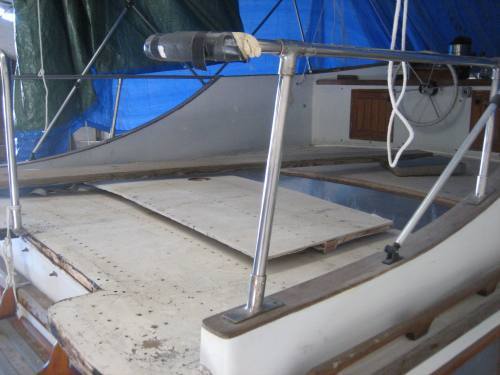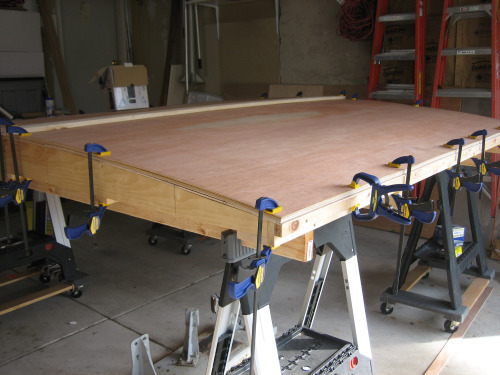Mike Jastrzebski's Blog, page 44
April 11, 2013
Welcome guest blogger Darcy Scott
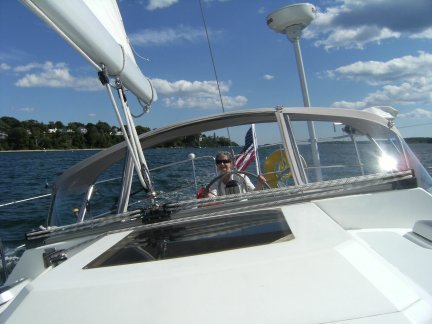 Christine: I am thrilled to share with you today another “writer on the water” Darcy Scott, who has taken her experience of many years’ cruising to write this delightful crime fiction series set in the waters off Maine. I’ll let her tell you all about it.
Christine: I am thrilled to share with you today another “writer on the water” Darcy Scott, who has taken her experience of many years’ cruising to write this delightful crime fiction series set in the waters off Maine. I’ll let her tell you all about it.
Darcy: Many thanks to Christine for slipping in my guest blog today! I’m a fellow writer/sailor (Maine Island Mystery Series) and new Seychelle Sullivan fan—my sister continually carrying on about Christine’s books until I finally agreed to pick up a copy of Surface Tension. Needless to say, I’m hooked. Christine then asked me to share my particular story and thoughts on writing with you, so here I am.
I first took to the water about 25 years ago when I met my husband—a life-long, balls-to-the-wall sailor and marine industry professional. Prior to that, I’d literally never been on a boat. Still, I felt a deep and immediate connection to the experience—the sense of freedom you have on the ocean, the connection with nature on a very elemental level. The fact I don’t get seasick was probably the deal clincher for him and we were married in 1994, living on our boat during the summer season, or as long as we can stretch it in southern Maine, which is usually from May through mid-October. Then we suck it up and move inland, about 20 miles west of our Kittery, Maine mooring, where we longingly begin planning boat projects and cruising destinations for the next spring.
Interestingly, I started writing around the same time I was introduced to sailing. I never put the two together before, but it makes sense. There’s something meditative about the motion of a sailboat, the stillness of a quiet harbor that trips my creative trigger. Some of my friends complain about the loss of household amenities, but it’s never bothered me. I love the simplicity of life aboard. The less “stuff” I have to take care of, the more creative time I have.
I began writing my first novel, one I call my “auto-bio-novel,” in 1995 when my husband and I took a year’s sabbatical to sail the eastern Caribbean. We’d usually spend mornings on the never-ending maintenance inherent in a 40-foot sloop (like most committed liveaboards, we do our own), then he’d head off in the afternoons to give a series of marine seminars, which left me delightfully free to spend them with my characters. It took 8 years to finish that first book, and I immediately began a second.
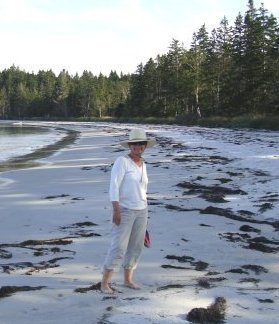 In the years since, we’ve sailed all along the east coast and beyond—as far north as the eastern tip of Nova Scotia and as far south as the bottom of Grenada—and raced to Bermuda any number of times. Still, our favorite cruising ground is the coast of Maine with its more than 4500 islands, and we spend a lot of each summer poking around Casco and Penobscot Bays where my Maine Island Mystery Series is set.
In the years since, we’ve sailed all along the east coast and beyond—as far north as the eastern tip of Nova Scotia and as far south as the bottom of Grenada—and raced to Bermuda any number of times. Still, our favorite cruising ground is the coast of Maine with its more than 4500 islands, and we spend a lot of each summer poking around Casco and Penobscot Bays where my Maine Island Mystery Series is set.
All islands have their own unique rhythms and social systems. This is as true in Maine as it is in the Caribbean, where neighboring islands are likely to be part of different countries—each with its own language, monetary system and social norms. In Maine, if you’re not born on a particular island, you’ll always be considered “from away.” I learned this one summer when we were sailing back from the Mount Desert area on a stormy afternoon and decided to duck into the small, single harbor on the island of Matinicus—a remote out-island notorious for its population of warring lobstering families who’ve been duking it out for generations and have little use for outsiders. Quaint this place is not. Rustic doesn’t really do it either. Its rather infamous history includes the early arrival of a few scrappy colonist families—ancestors of the same close-knit, lobstering clans still duking it out today—who decided to rid the island of the Native Americans so inconveniently in residence by killing and burying them in the vegetable garden.
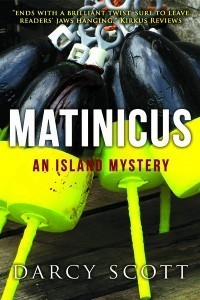 Today’s Matinicans have a well-earned reputation for being suspicious of mainlanders, unconcerned with social norms, and intolerant of bureaucratic niceties. They create their own addresses, see no need for license plates, and have so far resisted all efforts to establish an on-island police presence. Perfect place for a mystery, I thought, then spent two years writing the first of the Island Mysteries about the place. Called simply Matinicus (May, 2012), it includes a lot of the history and flavor of the actual island, and introduces the series’ protagonist—the hard-drinking, bachelor botanist Gil Hodges—a womanizer with an unfortunate propensity for psychotic, often homicidal women—praised by Cruising World Magazine as “the best male protagonist to come along since Lee Child’s Jack Reacher.”
Today’s Matinicans have a well-earned reputation for being suspicious of mainlanders, unconcerned with social norms, and intolerant of bureaucratic niceties. They create their own addresses, see no need for license plates, and have so far resisted all efforts to establish an on-island police presence. Perfect place for a mystery, I thought, then spent two years writing the first of the Island Mysteries about the place. Called simply Matinicus (May, 2012), it includes a lot of the history and flavor of the actual island, and introduces the series’ protagonist—the hard-drinking, bachelor botanist Gil Hodges—a womanizer with an unfortunate propensity for psychotic, often homicidal women—praised by Cruising World Magazine as “the best male protagonist to come along since Lee Child’s Jack Reacher.”
 As the story opens, Gil arrives on-island ostensibly to catalog the purported 22 species of wild orchid said to be found there, but is really running from the latest of these disastrous sexual conquests—figuring the place so remote, so rugged, so utterly unwelcoming to strangers it would deter even this latest bizzarro chick. Shortly after he arrives, however, islanders begin to die rather gruesome deaths and he’s forced to try and solve the murders in order to prove his own innocence.
As the story opens, Gil arrives on-island ostensibly to catalog the purported 22 species of wild orchid said to be found there, but is really running from the latest of these disastrous sexual conquests—figuring the place so remote, so rugged, so utterly unwelcoming to strangers it would deter even this latest bizzarro chick. Shortly after he arrives, however, islanders begin to die rather gruesome deaths and he’s forced to try and solve the murders in order to prove his own innocence.
Book two, Reese’s Leap (March, 2013), is set on another remote Maine island where Gil finds himself fogged in with five complicated, high-powered women partying their way through an all-female retreat. He’s initially pleased at the layover, but when a stranger appears out of nowhere with his own twisted agenda, things start to go terribly wrong, and it falls to him to keep the women safe, despite a dawning awareness that not everyone will make it off the island alive.
Gil continues his adventures in Ragged Island (Spring, 2015), the third book in the series, set on the little-known island of the same name. Considering the thousands of islands studding the Maine coast, the series may go on for quite a while!
 DARCY SCOTT is an ocean cruiser who spends summers plying New England waters. Her love of the rugged beauty of Maine’s sparsely populated out-islands serves as inspiration for her Island Mystery Series, which includes 2012’s award-winning Matinicus and the upcoming Reese’s Leap. Book three, Ragged Island, is currently in the works. Learn more at www.Darcyscott.net.
DARCY SCOTT is an ocean cruiser who spends summers plying New England waters. Her love of the rugged beauty of Maine’s sparsely populated out-islands serves as inspiration for her Island Mystery Series, which includes 2012’s award-winning Matinicus and the upcoming Reese’s Leap. Book three, Ragged Island, is currently in the works. Learn more at www.Darcyscott.net.
An excerpt from
Reese’s Leap
Prologue
July, 1912
Run, baby girl! Mama screams from her grave. Run!
And I be fast, too—lickety-split like she always say—rocks and shells cuttin’ at my feet as I claw my way up the hill. My breath all hitched and raggedy when I make the rise and creep under them trees that’s always so sweet and piney smellin’. My thinkin’ trees, Daddy calls ’em.
Through the branches I can see him and Willie bein’ marched down to the cove with the others—Willie spittin’ and fightin’ good as any man though he ain’t but six, Daddy gone all quiet as he peeks back to where I’m hid, his eyes catchin’ mine like they do, tellin’ me to stay put, stay quiet. That he’d be back for me.
Run, girl!
Ain’t but a half hour since they come poundin’ at the door—the one Mama always said ain’t nothin’ ever come through but bad news—Daddy awake first, slippin’ that old suspender over his shoulder as he picked his way past us in the dark. Willie still hard asleep on the cot, but me, I saw Daddy’s back go stiff, his eyes turn hard when he opened up—the faces of them mainland men all twisted and ugly with meanness, lookin’ me over like they ate somethin’ bad. It was then Mama told me to git.
There’s more of ’em movin’ up the hill with their torches now, puttin’ fire to houses I been in and out of my whole life, laughin’ as they step ’round Sally’s baby plopped down in the dirt, flappin’ her hands and cryin’, all big-eyed scared.
I look to the graveyard where our people is buried—a hundred years’ worth maybe. Mama laid out just last winter, not a week after bakin’ me my nine-years cake. Places in there I know to hide, places I can stay ’til Daddy and them come back, feedin’ myself on fish and berries, lyin’ in the sun.
Hide! Mama beggin’ me now, but my feet don’t listen, my eyes still caught on Daddy and Willie and the man pushin’ ’em hard toward the boats—Willie cryin’, which he don’t hardly do no more, even when the cat up and killed her kittens for no reason other than they’s gettin’ on her nerves.
I’m turnin’ to make for the graveyard like she say when I’m took up sudden from behind, a big man-hand slappin’ hard over my mouth, hot words whisperin’ in my ear. I kick the air, claw to get free—Mama’s voice fadin’ into Willie’s cryin’ and the hoarse shouts of ugly men, my heart like to burst ’til the darkness take me down.
Christine: Hey guys, a big part of what makes this blog so special is finding those other folks out there who share our passions for both writing and a life on the water. I am thrilled to have found Darcy and her books, and I hope you are too. Please take a look at Darcy’s books on Amazon here:
Fair winds!
Christine
Share on Facebook
The right tool in the wrong hands…
C.E. Grundler
“Oh, you mean the fellow with the belt sander,” came the reply on the other end of the phone.
A bad feeling ran up my spine. Belt sander? When you work in a boatyard, you often identify customers by certain traits, distinctions, or habits. The guy with the blue-eyed dog. The woman who always wears tie-dyed shirts. The dude with the long ponytail. But the fellow in question, the one with the belt sander, was at that time the owner of a boat I was coming to see. The boat I ultimately purchased. And the previously mentioned belt sander was, tragically, his preferred method of keeping the teak decks bright.
By the point my boat and I came together, the decks had been sanded, for the most part, clear down to the fasteners. In some cases, even the fasteners themselves had been sanded smooth. Which didn’t exactly aid in keeping the planks secure, or water out.
As a result, the decks suffered an abundance of leaks, seeping through the fiberglass beneath that teak, and into the coring.
The only saving grace was that the now saturated coring was also teak, sparing it from turning to a rotted mess. I knew this, and it was one of the reasons I was wanted this specific boat, despite the work I suspected she’d need. But it’s the work I couldn’t begin to imagine that bit me in the backside, to put it politely. Years of repeated freezing and thawing had taken their toll, delaminating a significant area of the bridge. And the more things came apart, the more apparent the extent of the damage became. And the more we began to realize this wasn’t going to be a simple repair.
This was around the point my husband began grumbling under his breath about taking a saw to the boat, and I suspect he wasn’t referring to repairs. Either way, it was time to take some drastic steps. Pictured below is the first section of the ceiling/deck being cut away. Ultimately, two thirds of the bridge deck were removed.
There was no turning back now. We constructed a new core, consisting of three layers of 1/4″ marine ply, laminated over a mold to duplicate the original camber.
It was easier to work on ground level, so we did this in the garage, then trucked the whole thing, mold and all, to the boat, then had it forklifted to a support set to bridge height.
At this point, folks around the yard were speculating that we were building a new cockpit enclosure. Not quite. But the structure supported the new core and allowed us to ease it into the space between the outer sides of the bridge, secure it, then laminate new ‘ribs’ into place. The screws you see were used to temporarily secure each layer as the epoxy cured.
Then the whole the whole area was glassed over with glass cloth and yet more epoxy.
And then it was time to tackle things from above, in this case with three layers of biaxial fiberglass/mat cloth, laid up with epoxy resin.
We’d saved the ‘skin’ of the rear contours of the bridge so we could more easily duplicate the original contours, and you can see that in the left side of the picture.
Next step, one more layer of biaxial, covering the entire bridge from end to end. Yes, it might fall along the range of overkill, but I can confidently tell you at this point the bridge is now rock solid, leak, (and possibly even bullet) proof. Anything worth doing is worth doing right.
As for those hole running along the sides of the bridge, I had cut access so I could pour in epoxy, filling the gap between the inner and outer walls of the bridge where it meets the deck — which was probably already completely sealed in previous steps, but then again, if you’re going to go with the overkill approach, you might as well go all out. It was an interesting process involving a funnel and section of hose, but sorry, no pics. I saved the cutouts, which were glassed back in place and faired out.
Today’s task will be the first barrier coats, and then topside paint and non-skid. It’s been one hell of a long, itchy, sticky road to reach this point, and in the end we’ll have a deck that looks like any other normal deck, which, I suppose, is a good thing. And lest anyone think the deck is the only thing we’ve been working on — the engine room, steering, and countless other mechanicals have been getting a complete overhaul as well.
As spring rolls around, we’re drawing closer to actually being afloat once again. Throughout the Sandy-battered boatyards, there’s a sense of optimism as things gradually return to some level of normal. Some boats are gone forever, hauled away to salvage yards, while some new (and new-old) boat have taken their place. Other boats have been professionally repaired and you can’t even tell what they’d been through. Some owners bought their storm damaged boats, or someone else’s boat, back from the insurance companies, and they’re learning the fine art of DIY fiberglass repair. Yet other boats escaped unscathed, and their owners are happily prepping for launch…including one merry fellow I passed the other day, blissfully sanding away at the teak decks on his boat. “Yeah, they leak a bit,” he explained, “but all decks do. And they look so nice after a fresh sanding.”
Share on Facebook
April 9, 2013
What are they really doing?
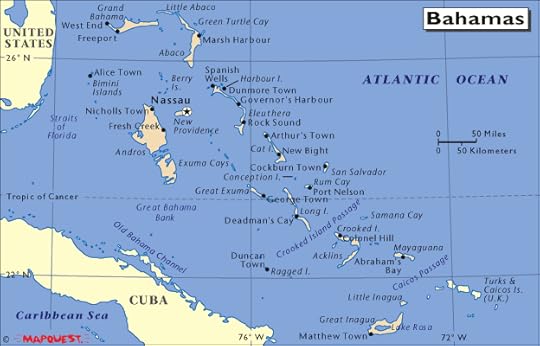
By John Urban
Fans of this post have read that Christine, Mike, and Mary are sailing the Bahamas aboard Talespinner and Rough Draft. Word is, Christine and Mike are working away on new books. Call me skeptical, but I’m thinking that they might also be doing a fair share of sunning and swimming. And perhaps downing a Goombay Smash or two in the evening.
Until we see more photos documenting long days at the keyboard, the mainland-based staff at Write On The Water thought we would post some eye candy photos of the Bahamas so that we might imagine what they are really up to over there.
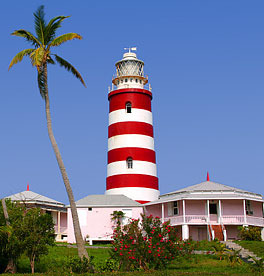
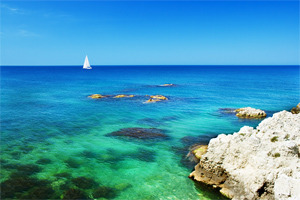
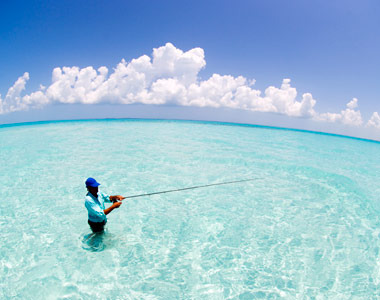
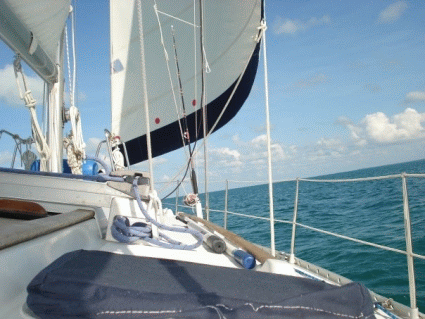

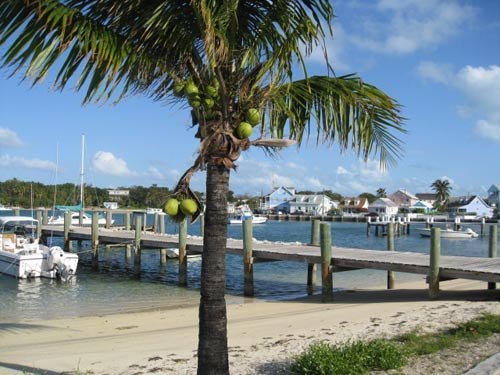
Share on Facebook
On the Road
No, not Jack’s novel, but me! I am on the last leg of my road trip to NY. I will write about it next time and tell you I know who the devil is and that hell is not all fire and brimstone, sometimes it’s so cold it burns.
I-95 south and soon I will be home.
Share on Facebook
April 7, 2013
Camp NaNoWriMo
By Mike Jastrzebski
April is Camp NaNoWriMo month, a new effort on the part of those who brought us NaNoWriMo, or the National Novel Writing Month every November for a number of years now. The purpose of NaNoWriMo is to get as many writers as possible to write 50,000 words of a first draft of a novel in thirty days.
Several years ago I took part in the program while working on The Storm Killer . That November I wrote just over 50,000 words of the book and it gave me a great boost toward finishing it. If you’re interested in seeing how that book turned out, it will be free on Amazon April 19-21.
. That November I wrote just over 50,000 words of the book and it gave me a great boost toward finishing it. If you’re interested in seeing how that book turned out, it will be free on Amazon April 19-21.
The reason I bring this up is that I signed up for Camp NaNoWriMo for April. I signed up for and originally planned to write 50,000 words of my next Wes Darling book, Stranded Naked Blues.
Somewhere along the way I decided that if I could write 50,000 words, or 1667 words a day, I could write 60,000, and if I could write one book, I could write two. And so although I kept my goal of 50,000 words for Camp NaNoWriMo, I shifted my personal goals a little.
My current goal is to write 36,000 words of Stranded Naked Blues, and 24,ooo words of The Believers, a fantasy novel for teens that I have been tossing around in my head for twenty-five years or so.
Here’s where I stand after 7 days: Stranded Naked Blues-9,215 words, and The Believers-5,228 words, or a total of 14,445 words in seven days, or 2063 words a day. If I can maintain this rate I will hit 61,890 words written in the month of April.
Now don’t get me wrong, this is first draft, a very rough first draft, and when I’ve completed the month I will still be many months away from having a publishable book.
This is why we returned to the Bahamas this year, to give me time to write. The problem is that I don’t have a lot of time left to enjoy paradise, but then there’s always next month.
So if you are reading this and have participated in NaNoWriMo in the past or are signed up now let us know about your experience. If you have never participated, let me know what you think of the idea of NaNoWriMo.
Share on Facebook
April 5, 2013
Writing is hard work
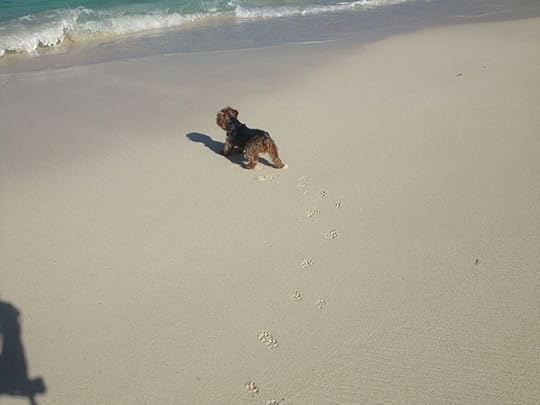
The Terror says to the Atlantic “Catch me if you can!”
by Christine Kling
I’ve been posting pictures on Facebook similar to the one above of me and my dog walking on the beaches of beautiful Man O War Cay in the Bahamas and some folks have been writing about what a great life I have. And indeed, it is pretty great, but that doesn’t change the fact that
Writing is hard work.
I get that it doesn’t look hard. I understand that I don’t have to put on pantyhose or drive in traffic or put up with an annoying boss (other than the Terror*). But trying to put the words together to create one scene after another, trying to decide if your character will turn right or left, travel by car or plane, kill or be kill, eat street food or go to a restaurant is hard work. Hardest of all is trying to get all the details right.
Don’t laugh. It really is.
Today I wrote two pieces other than working on my novel or this blog. One was a “conversation” between me and another author where we just chatted back and forth via Google docs. I wrote about something that I have never quite put into words before, and it got me to thinking. I wrote about this strange sort of competitive feeling I have towards men. I want to sail and write as well as men because you see, some of the writers and sailors I admire most are men. The other piece I wrote was a post in an online forum where people were writing about whether or not they read prologues. I found the conversation idiotic and I said as much. I wrote:
“If a story requires a prologue to tell it best, then use one. If it doesn’t then don’t. For heaven’s sake, don’t worry about whether or not it’s a current fad. Deciding to call a prologue chapter 1 won’t change it from being a prologue. A prologue is what it is due to the structure of the story, not the label you put on it. Here are a few books I’ve enjoyed that use a prologue to very good effect:
Peter Matthiessen’s AT PLAY IN THE FIELDS OF THE LORD.
Robert Goddard’s IN PALE BATTALIONS
Robert R. McCammon’s BOY’S LIFE
Carlos Ruiz Zafon’s A SHADOW OF THE WIND
If I could write half as well as any of them I’d be thrilled.”
In looking back at that list of books I like very much, books that are rich in accurate details, I realized, they were all by men. I consider all of those books to be both literary fiction and genre fiction, i.e. thrillers. And to be honest, I cannot think of a woman writer whom I could add to this list of authors(regardless of prologues).
And that pisses me off because it makes me realize I have a gender bias, too — and it makes me want to work even harder.
But when I am working on a scene and trying to conjure up what the people look like and what it all smells like and what they are saying and how that relates to their professions which are sometimes things I know nothing about — sometimes I despair. Who am I to create one character who is a geologist/mining engineer and another who is a chemist and then try to figure out what they would say to each other when discussing how to defeat gold fingerprinting that uses mass spectrometry? Who am I to attempt this?
That’s when I realize that my gender bias extends to me. I don’t really believe in my own ability to write the kind of books I love.
And that, my friends, makes the writing even harder.
Fair winds!
Christine
*aka Barney the Yorkshire Terror
Share on Facebook
March 31, 2013
The e-book Future: Google Glass & Car-readers
By John Urban

Google co-founder, Sergey Brin, has been making news with announcements of the company’s prototype device, Google Glass. The product, a wearable computer with a head-mounted display that delivers hands-free Internet search features, will be released in late 2013/early 2014.

(Google founder Sergey Brin wearing Google Glass glasses, photo courtesy of Reuters)
Google Glass may have implications for the e-book market, but the manufacturers of Kindles, Nooks, and iPads are working on their own product developments, the latest being a Car-reader, which projects the written page onto the windshield.
In some ways, the Car-reader technology isn’t entirely new. GM and BMW both offer head-up display technology in their cars that shows data such as vehicle speed and navigation instructions. But until now, this required factory-installed transparent phosphors lit-up by ultraviolet lasers inside the car.

(GM’s Head-Up Windshield Display)
Unlike these expensive factory installed devices, the new Car-readers rely on reflective Quasar-P technology, a new innovation that allows for simple dashboard-based units that have a price-point of $129. The business impact is dramatic. A February 29th article from the Wall Street Journal predicts a multi-billion dollar Car-reader market by 2015 with devices in more than half of all cars.

(Prototype Car-reader; Quasar-P technology translates the screen to windshield text.)
Car-readers are, however, raising concerns from some government officials. An official from the US Highway Safety Commission who spoke off-the-record stated: “It’s very interesting technology, but reading a book while you are at the wheel may have a negative impact on the problem of distracted driving, especially if it’s a really good book that absorbs the driver in a story-line.”
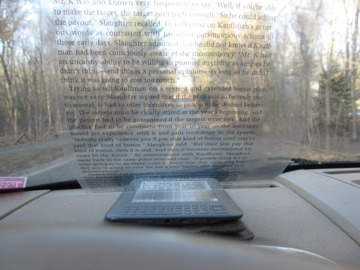
(A generation-2 Car-reader.)
And politicians are taking note. New Jersey Governor Chris Christie has gone on the record saying, “This is stupid.” In fact, New Jersey is one of five states seeking to restrict Car-reader use by drivers.
But others are less skeptical. They also point out that drivers already listen to books on tape. A participant in an early Car-reader trial put it this way. “I drove from Maryland to Florida over the holidays. Thanks to the Car-reader I stayed awake the whole time, looking straight ahead, eyes locked on the windshield. People who haven’t used Car-readers don’t understand that you can safely drive and read at the same time.”
“I understand the initial skepticism,” stated an industry representative. “But if we are going to expand the economy and add jobs, we need to embrace change. And with future versions you will also be able to search the web, which gets us to a whole new level.”
Testimony before officials in Washington seems to support the Car-reader supporters. In a hearing held by the Interstate Commerce Commission, which oversees trucking, experts testified that Car-readers keep truckers more alert on long runs, especially when driving at night. The Federal Airlines Administration (FAA) is also assessing whether or not commercial pilots should be allowed to read books in flight using the new technology.
There are also educational benefits. For example, one equipment provider conducted a test in conjunction with classes offered by the French-American School of New York City.
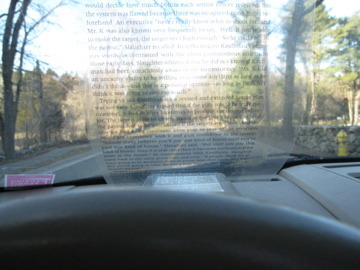
(Example of a Car-reader as a learning tool.)
According to school head, Mademoiselle Poisson d’Avril, students commuting to school by car were able to learn French 45% faster when using the Car-readers in their cars in conjunction with the audio book feature. “Yes, we had an accident, perhaps two, but any new technology requires adaptation. The mind’s language learning is best when we both hear and see words. If everyone in New York drove around with Car-readers we could realize our multi-lingual ideals in a matter of months. Imagine a world in which you could understand people approaching on the street as they greet you by saying:
Feliz Día de los Inocentes
or Glückliche Aprilscherz
or Buon Pesce d’Aprile Giorno.”
But until then, we’ll have to be satisfied with: Happy April Fool’s Day.
Share on Facebook
March 28, 2013
There’s always a better way

Barney the Yorkshire Terror
by Christine Kling
And I guarantee you that if you are a female solo skipper traveling around with the Yorkshire Terror, somebody is always going to stop to tell you about it.
The other evening I was doing my laundry at the Green Turtle Club and this woman and her little boy came over to see the dog. Barney gleefully jumped up on the boy, but it frightened him. I apologized and the lady said, “You really should train him not to do that,” and then she launched into her story about how she trained her dog with a spray bottle full of water.
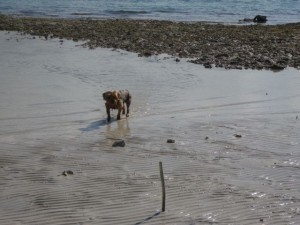 I wanted to say, “You don’t think I’m trying, Lady?” This little dog is the most hard-headed, stubborn beast on the planet. I’ve watched videos, bought special leashes, worked with food treats – you name it – and still, when the Terror gets fixated on something, whether it is running away down the beach or barking at the flag flapping in the wind, there is no getting his attention.
I wanted to say, “You don’t think I’m trying, Lady?” This little dog is the most hard-headed, stubborn beast on the planet. I’ve watched videos, bought special leashes, worked with food treats – you name it – and still, when the Terror gets fixated on something, whether it is running away down the beach or barking at the flag flapping in the wind, there is no getting his attention.
But dog training is only one of the areas where folks have been telling me that there is something wrong with how I’ve been doing things. Several days ago, I decided I didn’t like the place where I was anchored because the wind was soon going to clock around ninety degrees, and I would be too close to a bunch of nasty-looking old dead coral. I decided to go visit with another female solo sailor and ask her opinion. We sat there in her cockpit discussing the various spots I could move to when a fellow came by in his dinghy. He stopped by and then launched on a thirty minute rant on “How to anchor 101.”
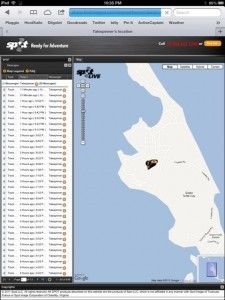 When I finally did move my boat, I decided to set two anchors because I was going to be in the middle of several moored boats. When I dropped the first anchor just ahead of and close to a moored boat, a fellow on another boat yelled out, “Hey, there’s a boat behind you!” I turned and smiled and nodded – meanwhile nearly drawing blood as I bit my tongue.
When I finally did move my boat, I decided to set two anchors because I was going to be in the middle of several moored boats. When I dropped the first anchor just ahead of and close to a moored boat, a fellow on another boat yelled out, “Hey, there’s a boat behind you!” I turned and smiled and nodded – meanwhile nearly drawing blood as I bit my tongue.
And recently, I’ve been getting lots of emails telling me that there is something wrong with this new Spot Connect of mine. Folks are telling me that it has got me high and dry smack in the middle of Green Turtle Cay. If you check out the picture at left, you will see what I mean. You see, the Spot devices use Google Maps on their website and in spite of all the years they’ve had to perfect their
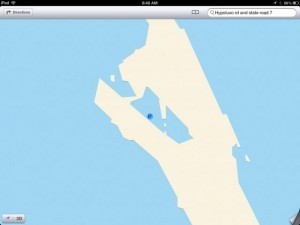
Apple’s Maps app
cartography, they haven’t figured out yet that there is a lagoon in the center of the island.
I know there was a big stink when Apple dropped Google Maps for its Location Services and instead put out their own proprietary mapping system that still had some problem areas. However, when it comes to Green Turtle Cay, at least Apple’s Maps app (try saying that 5 X fast) shows the big lagoon (though one might well wonder how the boat managed to get inside without wings).
And finally, to get an idea how the different cartography interprets some of the same data, here are two screen shots that show my same location using the two major iPad navigation programs. The last time I wrote about iPad Navigation apps, I was told in the comments that my first choice for a Nav app was wrong.
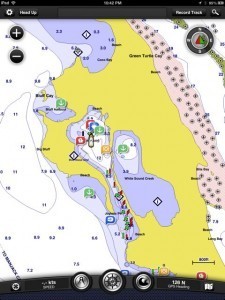
Garmin Blue Chart
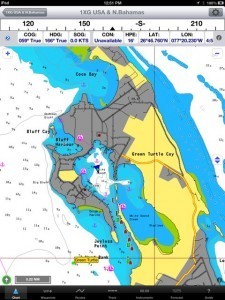
iNavX with Navionics charts
This time, I really would like your opinion. Which do you prefer?
Fair winds!
Christine
Share on Facebook
So, do you want the bad news, or the good?
C.E. Grundler
I have to confess, I have a love/hate relationship with the news. On one hand, from a writer’s perspective, you couldn’t ask for a better source of inspirational material. Murder, mayhem, the general decline of civilization and the lowest examples of human nature, they all make for sensational headlines. There’s everything you could ever imagine when it comes to the unimaginable, and then some. A quick scan of the day’s offerings often leaves me shaking my head in sadness and disbelief. These stories aren’t fiction – they’re actual people, actual lives and deaths. They’re a sad side of the world we live in these days, and it seems as though things are progressively taking a turn for the worse. Perhaps, or maybe the world had always been this way, but thanks to the wonders of the interwebs we are now that much more aware.
By the nature of the news, the most horrific headlines often get top billing. What’s the old saying? “If it bleeds, it leads.” And that bleeding comes in a range of topics, from humanity to politics, finance to the environment, not to mention the daily crop of celebrity train wrecks. It’s enough to bring even the most optimistic soul down. But I’ve found an antidote – though it takes some work. Like diamonds hidden within tons of coal, there are good bits of news to be found, though they usually get buried beneath the bad. The trick is to scroll down the page, past the appalling, the gruesome and tragic. Often, I find the most hope for the world as a whole hidden in the corners of the science news. There’s no question our climate’s a mess, our oceans are awash in plastic, and our energy hungry population needs better sources of power. But I suspect these recent stories spotlighting some groundbreaking solutions weren’t sensational enough for the mainstream media. After all, with mass shootings, sports stars being traded and Kardashians gaining or losing weight, who really cares if some researchers have discovered a way to cheaply and safely trap CO2 emissions, based upon studies of sea urchins. Or how some scientists messing with graphite and scotch tape may have come up with a safe, non-toxic, inexpensive and exceptionally efficient new super-capacitor, which could revolutionize powering everything from cellphones to cars. Or the 19 year old who developed an award-winning system that could be the key to removing 7,250,000 Tons Of Plastic From the World’s Oceans.
In the end, the world’s news can be overwhelming. But if you sift down and read a little further, you can still find some good news… you just have to look beyond the bad.
Share on Facebook
March 26, 2013
Life On The Hook
By John Urban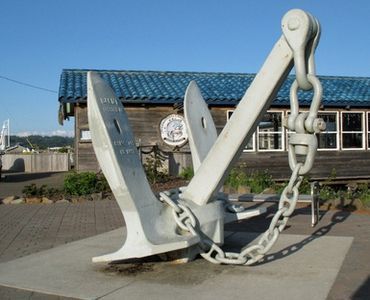
Have you ever woken up in a sweat after dreaming that the brakes in your car didn’t work?
If you’re a boater, you have probably also had the equivalent nightmare of dreaming that you are asleep aboard your boat and the anchor drags. And if you’re a seasoned boater, that nightmare likely has more than a tinge of reality associated with it.
Over the years I have done a significant amount of anchoring. I know about letting out lots of line (boaters call this scope) as a way to achieve a better set. I am aware of the need to understand whether or not the bottom is rocky, sandy, or muddy. And I understand that using chain further secures the hook-up because it lays the line lower, giving you a firmer hold.
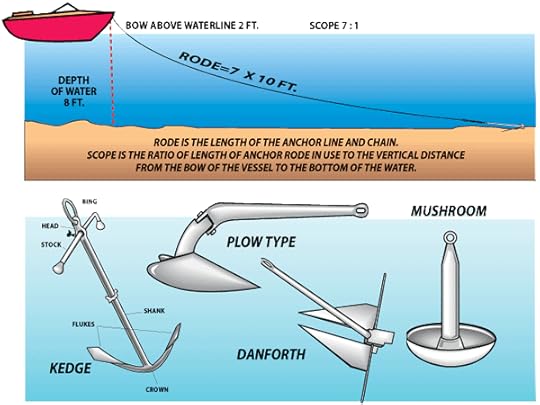
Yet, most of my anchoring has been the daytime type, the let’s stop here to fish or have lunch variety. Overnight anchoring? Not so much.
I have a vivid memory of the first time we left our sailboat at anchor for an extended period of time. We took the dinghy to shore and walked around. Forty-five minutes later, I was pleasantly surprised to see the boat still safely at anchor. Being an optimist, I was pretty sure it wasn’t going to end up on the rocks. Being a boater, I was certain that some calamity was going to occur, running aground on the sandy beach seemed the most likely. But I was wrong. Everything was okay. Two hours later, it was still okay. I was even more surprised that night – yup, we were still secure. By the second day, I was damn proud to be an anchored boater. I was independent! I was off the grid! I was detached from the Nanny State of moorings and docks!
But we are talking about boating. That night, the wind blew up forcing boat after boat to drag their anchors. By 8AM the next morning, our own anchor slipped. It turned out that a broken winch handle down there in the mud worked its way into one of the flukes of our anchor. Despite the cause, the plain truth is that all that machismo and independence was a fleeting experience. And you know what? I am far from alone.
Enter, the question eternal – what type of anchor will best secure a boat?
For those wishing a response to this question, I have good news: your query has been answered. The bad news? There are many answers. In fact, everyone seems to have their own answer. The types and brands that people swear by is a seemingly endless list – CQR, Delta, Ronca, Bruce, Plow, Danforth, Kedge, Hall, Fisherman, Mantus, Fortress, on and on. Each answer different, conflicting, and authoritative.
With Spring upon us, I find myself needing to resolve this question. I want my independence back and I aspire to drop my anchor where others won’t go.
And as I write this, several writers from this blog are living the dream on the hook in the Out Islands of the Bahamas – I await their reports. But I am still stuck in a quandary, yet open to suggestion. So if you have some special knowledge on this subject, please feel free to drop by anytime – I am quite sure you will find me tied-up to Mooring ball #80, F. L. Tripps Boatyard, Westport, MA.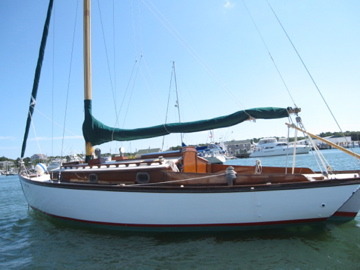
Share on Facebook

